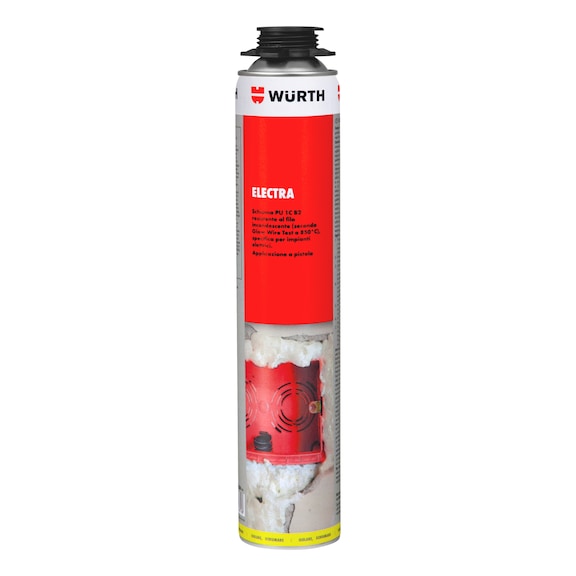For detailed information, other images and documents, please select individual articles from the following table.
Single-component polyurethane foam ELECTRA
PU foam specifically for installing electrical systems, glow wire tested at 850 °C. Application via gun
Register now and access more than 125,000 products


Variants
Register now and access more than 125,000 products
- Once the polymerisation process is completed and perfect hardening is achieved, ELECTRA polyurethane foam is glow wire resistant
- Tested and certified according to the glow wire test at 850 °C (reference documentation CEI EN 60695-2-10:2014-03 / CEI EN 60695-2-11:2014-08 / test report no. RSP31601 of 05/06/2024 BTICINO (SALA PROVE BTICINO) VARESE testing facility)
- The special formulation also means it can be used at temperatures below zero, down to -10 °C
- ELECTRA reacts with moisture in the air, increases in volume, hardens and transforms into a semi-rigid waterproof foam
- It prevents the creation of thermal and acoustic bridges in sealing points between cable grommet pipes, junction boxes or insulating socket boxes and masonry
- ELECTRA adheres to most conventional building materials such as: plaster, gypsum plasterboard, wood, concrete, brick, asbestos, metal, glass and plastic
- Thanks to the dimensional stability and mechanical properties of the product once hardened, ELECTRA is ideal for bonding, fixing, insulating, soundproofing, sealing and plugging the components of an electrical system in both walls and floors. Once hardened, the foam can be cut, drilled, sanded, painted and plastered
- The extremely low VOC emissions make it perfect for indoor use
- The PU foam cannot withstand direct exposure to UV rays. Protect it immediately after it fully hardens with plaster, paint, acrylic sealant, silicone etc.
- The product does not adhere to PP, PE, PTFE, silicones and surfaces treated with release agents
- The foam will not adhere to surfaces that are completely saturated with water
- To obtain a good yield, it is recommended to store the spray can at a temperature of approximately +20 °C, but never below +5 °C. At low temperatures, both the pressure of the fresh product leaving the valve and the yield of the cured foam decrease
- Installation of electrical systems in general
- Mounting and insulating socket boxes, appliance connection boxes, corrugated pipes etc.
- Filling cavities in the presence of electrical systems
Benefits of fastening with polyurethane foam compared to mortar:
- Quick to use: When applied with a dispensing gun, polyurethane foam is easy to apply precisely, for a significant reduction in processing time
- Worksite cleaning: Foam does not generate dust and equipment is quicker and easier to clean compared to mortar
- 1. Check that the support is free of oil, grease, dust and loose materials
- 2. Moisten the surface slightly to allow the product to form a uniform cell structure
- 3. Remove the protection cap from the spray can and screw on the special dispensing gun
- 4. Shake the spray can vigorously for at least 15 seconds before use. This operation must be repeated every time you restart your work
- 5. During application, hold the spray can upside down, with the valve pointing downwards. Direct the tip of the gun to the work area and apply by pressing the dispenser trigger. Do not fill the cavities completely: ELECTRA's low post-expansion is sufficient to fill the residual gap and avoid wasting product
- 6. If there is low environmental humidity, the product must be moistened (e.g. using a sprayer) immediately after application
- 7. In the event of short interruptions during the job, the spray can may be left screwed onto the gun but the screw at the back of it must be tightened
Select RAL-colour code
!! NOTE: On-screen visualisation of the colour differs from real colour shade!!



